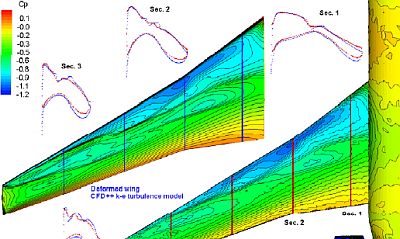
Optimization of wing efficiency vs. sweep angles using mesh morphing
Biancolini Marco Evangelos - Università di Tor Vergata (Italy)
Mancini Michele - Piaggio Aero Industries (Italy)
Cella Ubaldo - Piaggio Aero Industries (Italy)
Travostino Giorgio - Piaggio Aero Industries (Italy)

PRESENTATION
Abstract
This study has been conducted within a Research partnership active since 2009 between Piaggio Aero Industries & University of Rome Tor Vergata addressed to the solution of the aeroelastic problem using the mesh morphing software RBF Morph and recently extended to shape optimization methods. A wind tunnel model of a business class aircraft in complete configuration validated using experimental data from a test campaign performed by Piaggio in the ONERA S2MA transonic facility is considered as the baseline geometry. Sweep angles are changed for both wing sections
keeping the leading edges straight, preserving the wing area imposing relative movement between root section, kink section and wing tip using an accurate two step morphing strategy. A first RBF solution is used to reshape the wing (step 1), the set-up is then completed limiting the morphing domain with a box and constraining other surfaces (step 2). The quality of the mesh is verified in advance for full range of both modifiers. The baseline Fluent model is iterated until a good convergence is achieved (1500 its). Such model is then parameterized using custom parameters to update shape at initialization; each shape is calculated (500 its) starting from converged flow solution of baseline. Drag and Lift are exported as output parameters (Cd, Cl). Shape parameters (eps-1, eps-2) are steered from Workbench whilst efficiency is computed as a derived parameter. MOGA algorithm is used on Kriging response surface (optimal space filling points + validated optimal candidates). As expected slight improvements are achieved (less than 1%) with respect to the baseline, already optimized for the same flight condition; nevertheless a wide variation range of efficiency (25%) is observed in the design space, near the maximum the optimal area exhibits a flat behavior.
